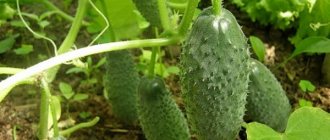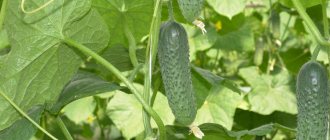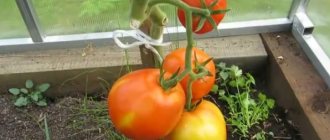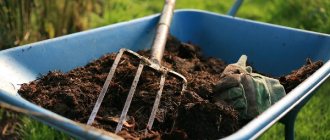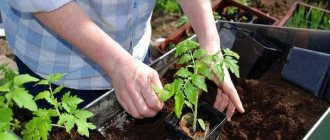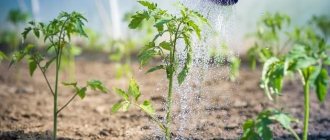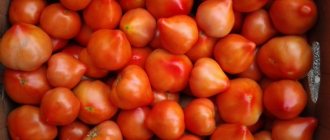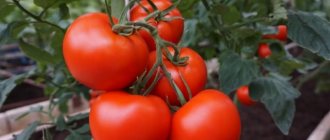History of variety development
This hybrid was created by breeders O. N. Krylov and A. V. Borisov, who work in agriculture. When breeding the variety, experts tried to instill in it the following qualities - early ripening of fruits, bunch type of flowering, good yield. As a result, the new cucumber hybrid Faithful Friends meets all these requirements.
The True Friends cucumber is recommended for planting in most Russian regions and is intended for cultivation in private backyards and on an industrial scale.
Cucumber True friends F1: description of the variety
This cucumber hybrid is distinguished by the early ripening of greens - a little more than a month passes from the moment the shoots appear until the gherkins are harvested.
The vines of this variety are of medium size, about 2 m in height, well leafy, the number of side vines formed is average, so there is no need to form cucumber bushes. This makes caring for this variety of cucumbers easier.
Photo of cucumber True friends F1
The foliage is medium in size, slightly wrinkled and finely jagged along the edges, light emerald in color.
Bundles of ovaries are formed in short internodes, each of which produces up to 10 cucumbers.
Ripe cucumbers True friends - gherkin type,
their shape is cylindrical, thicker at the base and slightly tapering towards the tips of the fruit.
The sizes of the fruits are approximately the same - up to 10 cm in length and about 4 cm in diameter. The weight of True Friends cucumbers is up to 100 g
. The skin is compacted, crispy, with small tubercles, the pubescence is small, with small black spines. The color of the cucumbers is soft emerald, with short stripes of white; the base of the fruit is slightly lighter.
The pulp is slightly compacted, tender, has no bitterness, the aroma is typically cucumber.
Advantages of cucumbers
The charm of “True Friends” has already been appreciated by many summer residents. What is special to note about these cucumbers?
- The versatility of the variety allows you to both pickle the fruits and eat them fresh.
- They are not afraid of changes in climatic conditions and tolerate sudden cold snaps well.
- They are practically not susceptible to classic cucumber diseases, which increases the safety of the crop.
- The variety “True Friends” is distinguished by the fact that it ripens early.
- There is no need to form cucumber bushes, as they grow small.
If we talk about shortcomings, then we can note that there are none at all. True, every gardener can note some nuances for himself personally. For example, many people prefer to grow cucumbers and tomatoes in greenhouses, which is not suitable for this variety. Since it is bee pollinated, it is recommended to plant it in open areas or in open greenhouses.
Application area
Collected gherkins are universally used; they can be eaten fresh, added to salads, pickled and salted, and also used to cover other preparations for the winter.
On a note!
The greens of this hybrid tolerate heat treatment well, while no voids are formed inside, and their taste qualities of the cucumber True Friends do not change.
Tips for choosing seeds
If you cannot determine which variety of cucumbers to plant this year, we advise you to pay attention to several factors. When choosing cucumbers, not only their size or shape matters:
- Pay attention not only to the presence or absence of thorns, but also to their size and number.
- If cucumbers have white spines, then they are not suitable for twisting. Can only be used in salads. It is noteworthy that only these varieties of cucumbers are sold in stores.
- Fruits with dark spikes are more versatile. They can be either pickled or added to a salad. True, you should be careful and harvest on time, as they quickly overripe.
- It is best to choose a variety that suits your climate and region. Such varieties are developed taking into account the characteristics of your area, are better able to tolerate possible diseases and produce more yield.
- When planting cucumbers, divide them according to their intended purpose. Salad - separately, for pickling - separately.
- If you choose several varieties, it is best to select them so that they produce crops at different times. Early and late cucumbers differ not only in their taste, but also in their resistance to weather conditions.
- Varieties with female flowering should be combined with a pollinator. Otherwise, your seedlings will look more like a flower bed than a bed of cucumbers.
Not so long ago, geneticists from the UAE, after spending many years and an incredible amount of money, were able to breed square cucumbers. Interestingly, they are much more transportable than oval ones, and at the same time, they do not differ at all from the usual taste.
When choosing cucumbers, always take into account their characteristics and your preferences. As for the “True Friends” variety, it deservedly received the approval of avid summer residents. Its main advantage is that it tolerates sudden cold snaps well, which means you don’t have to worry about the safety of your crop.
Diseases and pests
This cucumber hybrid is characterized by fairly high resistance to most diseases characteristic of other varieties of cucumbers, including brown spot and cucumber mosaic virus.
Among the pests, cucumbers of this variety can infect aphids and spider mites
. You can fight these “harmful” bugs using traditional methods - treating the foliage with a soap solution or infusion of pepper. If there are too many insects, then you have to spray the plants with appropriate insecticides. But the last treatment with such substances should be carried out 12-14 days before harvesting ripe gherkins.
Photo of aphids on cucumbers
Photo of spider mites on cucumbers
Care
Agro, which is the originator of the hybrid True Friends, is popular among gardeners. The manufacturer places an emphasis on the production of hybrids and types of cucumbers, which are extremely adapted to the difficult climatic conditions of domestic areas.
The cucumber variety Faithful Friends is undemanding, but with proper care it will delight you with a wonderful harvest. Essential events include:
- constant watering and humidity control (especially when growing in greenhouses);
- fertilizing plants (up to 5 times per season);
- preventive measures against various infections.
Watering
You cannot harvest cucumbers without providing the plants with good, constant watering. Cucumbers prefer water, but at the same time they cannot tolerate too much of it and tend to get sick. For this reason, water the bushes only with warm water, taking into account atmospheric conditions and air temperature.
On hot days, water more - every other day, in cloudy weather - less often, reducing the volume of water. Cucumbers on ridges often receive enough rainfall during the first period of the growing season, but from the stage of flowering and fruit development, watering can be increased.
Feeding
Humus, poultry droppings, ash, and a variety of mineral fertilizers are used as fertilizers for cucumbers. The selection of different compositions is huge, some people only like natural fertilizing, excluding “chemistry,” while others happily alternate between mineral fertilizers and organic matter. Among the fertilizers “adored” by cucumbers, we emphasize:
- mullein (diluted in water 1:10);
- bird droppings (1:20);
- wood ash (infusions in water, dusting the soil).
Excellent results are demonstrated by feeding the hybrid with simple baker's yeast. Prepare solutions for watering (dilute approximately 200 grams of yeast per liter, infuse, add up to 10 liters of water and water under the bush) for spraying.
When using yeast for “lunching” cucumbers, you should use a non-expired product. Root feeding is effective in hot summers.
If the atmospheric conditions are unfavorable, the days are cloudy and cold, it is recommended to spray the cucumbers with a generous composition.
Pollination
Hybrid True Friends will require the presence of insects for pollination, otherwise there will be significant losses in yield:
- Planting pollinator species can help, as well as attracting bees and bumblebees to the area. It is possible to spray cucumbers with sweet syrup, which attracts insects.
- In addition, when growing such cucumbers, it is important to sow honey plants nearby: flowers, herbs.
The long period of fruiting makes it possible to collect hybrid greens until the very last days of summer. Cucumbers are removed constantly if they reach a length of 7-8 cm.
Did you like the variety Faithful Friends?YesNo
Advantages and disadvantages of the variety
The main advantages of the True Friends hybrid include:
- early fruit ripening;
- cucumbers – smooth, gherkin-type, with good taste;
- this hybrid calmly tolerates changes in weather conditions and is not afraid of short cold snaps;
- the harvested crop can be transported to any distance, and also stored in appropriate conditions for a long time;
- cucumber True Friends is highly resistant to major diseases characteristic of other varieties of cucumbers;
- cucumber lashes do not require shaping.
This hybrid has no particular disadvantages, but it should be remembered that the True Friends cucumber is bee-pollinated, so it should be grown in garden beds. And the seeds of this hybrid have to be purchased annually at specialized gardening outlets or via the Internet.
Planting bushes
Before planting the hybrid, the seeds are germinated, the seeds are dipped in warm water, left to swell, after which they are caught and laid out on a damp piece of cloth. After a couple of days, the seeds hatch.
Open ground
Planting cucumbers in unprotected soil begins in the second half of May. The soil for cucumber beds is dug up, manure or bird droppings are added to it, and weeds are removed.
The predecessors of cucumbers can be tomatoes and potatoes. Cucumber bushes should not be placed in places where watermelon, melon, zucchini, carrots or beans grew last year. The beds are laid out in a well-lit area.
Seeds are sown until mid-June. Later sowing will not allow the plants to develop normally. Cucumbers do not like long daylight hours: this entails fatigue and weakness of the crop - bouquets of ovaries will not be able to develop normally.
Seedling
Strong seedlings will provide a good harvest
For seedlings, germinated seeds are buried 2 cm in pre-prepared soil. Ready-made mixtures are sold in specialized stores. You can also prepare the soil yourself. To do this, take 2 parts humus, 1 part peat and 1 part sawdust.
Recommendations for growing seedlings:
- Plastic cups are ideal as containers for seedlings. Cucumbers Friends do not tolerate picking well.
- The temperature in the room with seedlings is maintained at 20°C. Cucumber sprouts are watered and fertilized sparingly.
- After the appearance of the second true leaf, the seedlings are taken to a permanent place in the greenhouse.
Agrotechnics of cultivation
Cucumber seeds True Friends should be planted in greenhouses and film greenhouses in the second ten days of May, and in open ground - in early June. In this case, you need to pay attention to the fact that the soil should warm up to 16-17 degrees Celsius by the time the seeds (or ready-made seedlings) are planted.
Agricultural technology for growing cucumbers - video
If the True Friends cucumber variety is grown by seedlings, then the seeds are sown in separate containers approximately 20-25 days before transplanting the plants to a permanent place.
Since this variety of cucumbers is bee-pollinated, several colored seeds of a pollinating cucumber are usually added to a bag of seeds of this hybrid so that these two varieties are grown in the same bed for further cross-pollination of the plants.
Growing cucumber seedlings
Sowing cucumber seed material True Friends for seedlings is carried out in the last ten days of April - the first ten days of May in such a way that in mid-May the grown seedlings are already transferred to unheated greenhouses or greenhouses, and in early June - to garden beds in open ground.
Cucumber seeds True Friends are purchased from well-known agricultural companies - manufacturers of seed material, where their pre-sowing preparation is carried out. As a result, before sowing, you only need to soak the seeds in growth stimulants for germination.
Photo of cucumber seeds True friends
Important!
Shoots of planted dry seed material appear 4-6 days later.
Cucumbers have a very delicate root system, which is easily damaged during transplantation; as a result, plants in a new place get sick for a long time, acclimatize worse, grow weakened, as a result, greens form more slowly, and productivity suffers. Therefore, to avoid picking, cucumber seeds are placed immediately in separate containers when planting.
.
During cultivation, cucumber seedlings of the Faithful Friends variety are fed twice with any organic matter - infusion of mullein or chicken manure. 10-12 days before planting the seedlings in a permanent place, they should begin to be hardened off - taken out into the fresh air, first for 30 minutes, gradually increasing the time the growing seedlings spend outside.
Transplantation to a permanent place
The beds for planting tomato seedlings are prepared in advance - the remains of vegetation are removed, humus or compost is added, and they are dug up.
In greenhouses, it is advisable to remove the top layer of soil about the length of a spade and lay out a new nutrient substrate containing turf, humus, wood ash and river sand. Such soil is disinfected before planting - spilled with a weak solution of potassium permanganate. All greenhouse structures should also be disinfected.
Photos of transplanted cucumbers
Advice!
In greenhouses, two True Friends cucumber plants are planted in one square, and no more than 4 in open ground.
The seedlings are transferred into planting holes along with a clod of earth, sprinkled with soil, watered and mulched with straw or mown grass.
Landing
It is recommended to grow the hybrid in open ground or under film, easily disassembled shelters. Planting in a greenhouse is allowed, but during the flowering period you need to remove its roof to give access to insects, or carry out forced pollination yourself, otherwise the fruits will not set.
The soil should be no colder than 16. The air temperature should be set at an average daily level of 20 with night temperatures not lower than 8.
Separate peat pots with a nutrient substrate are prepared for seedlings. One grain is sown in them, moistened and allowed to germinate in the warmth. Then the temperature is reduced to about 20 and the sprouts are transferred to the windowsill, where the sun's rays fall.
During the growth period, you can feed the seedlings once or twice with weak solutions of mineral fertilizers. A month later it is transferred to the beds.
Before planting in open ground, the soil is dug up in the spring and a bucket of compost or humus is added per 1 square meter. m. If the soil is depleted by constant cultivation of vegetables, add mineral fertilizers - 15 g each of superphosphate, urea and potassium nitrate.
For cucumbers, make 3-4 holes per 1 sq.m. The seeds are sprinkled with earth, mulched on top with a layer of peat or compost and covered with film. It is removed when sprouts appear.
Further care for cucumbers True friends
In the future, these cucumbers should be provided with regular watering, fertilizing, loosening the soil and removing weeds.
Interesting article:
Aphids on cucumbers
Irrigation regime
Cucumbers are demanding on soil moisture, so you need to water regularly as the soil dries out with warm, settled water. Water the cucumber vines strictly at the root, making sure that drops of moisture do not fall on the foliage and stems.
Important!
Moisture should not stagnate in the soil, otherwise the plants will begin to get sick.
In hot weather, cucumbers need to be watered more often, and during the rainy season, the amount of watering can be reduced to a minimum. During the growing season, cucumbers receive enough rainfall, but during the period of budding and ripening of cucumbers, this vegetable crop should be watered regularly.
Pollination characteristics and disease resistance
The True Friends variety is a bee-pollinated hybrid. To increase yield, it is necessary to attract pollinating insects with an organic sweet solution. Honey and/or sugar syrup works well.
Advice!
You can plant honey plants nearby (strong-smelling garden flowers or herbs) that attract bees.
The growing season of the variety is 40-45 days.
Strongly resistant to the main types of diseases:
- cucumber mosaic;
- olive spot;
- cladosporiosis;
- brown spotting;
- powdery mildew;
- downy mildew.
However, rhizoctonia, fusarium, and pythium pose a serious danger.
To prevent these diseases, you should follow the following rules of care:
- avoid excess dampness;
- pull out weeds on time;
- observe crop rotation - do not plant in areas after pumpkins, melons, and zucchini.
The plant must be sprayed against pests. It is especially susceptible to attack by insects characteristic of melon crops, such as melon aphids and slugs. When planting in greenhouses or greenhouses, you should be wary of spider mites. This pest first attacks the leaves of the plant, and then the flowers and young shoots.
Note!
The mite always appears in hot weather, but you should look for it in the plant’s own shade. For example, under the leaves or at the roots.
Excess dampness always attracts aphids. Especially if there are beds with melons nearby or gardeners do not follow the rules of crop rotation. Aphids dry out the plant because eats juice. Dangerous primarily for leaves and stems. If desired, you can carry out early etching of the soil in order to:
- prevent pests;
- remove fungal formations.
This must be done in advance, because the True Friends variety is an early ripening variety. The appearance of a slug can be avoided by sprinkling the beds with tobacco, but the plant then acquires a characteristic smell. You can also use allspice or rosemary. Infusions of chamomile or tobacco will help get rid of bedbugs, and preventative treatment of bushes with infusion of hot pepper will prevent the appearance of aphids.
